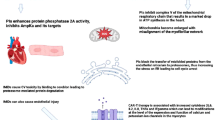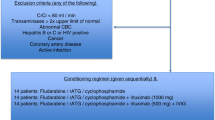Abstract
Cyclophosphamide (CPA) is widely used for peripheral blood stem cell mobilization, and a dose adjustment of CPA in the presence of renal failure has not been suggested. However, we describe a myeloma patient with renal failure (serum creatinine 4.2 mg/dl, creatinine clearance 11.2 ml/min) receiving CPA 2 g/m2 for 2 days, who developed unexpectedly severe toxicity, including myopericarditis and prolonged myelosuppression. The serial serum concentrations of CPA metabolites were persistently much higher than those in a myeloma patient with normal renal function. We consider, therefore, that the dose of CPA should be reduced in the presence of severe renal failure when used as high-dose therapy or to mobilize peripheral blood stem cells. Bone Marrow Transplantation (2000) 26, 685–688.
This is a preview of subscription content, access via your institution
Access options
Subscribe to this journal
Receive 12 print issues and online access
$259.00 per year
only $21.58 per issue
Buy this article
- Purchase on Springer Link
- Instant access to full article PDF
Prices may be subject to local taxes which are calculated during checkout


Similar content being viewed by others
References
Alexanian R, Dimopoulos M . The treatment of multiple myeloma New Engl J Med 1994 330: 484–489
Attal M, Harousseau JL, Stoppa AM et al. A prospective, randomized trial of autologous bone marrow transplantation and chemotherapy in multiple myeloma New Engl J Med 1996 335: 91–97
Bramwell V, Calvert RT, Edwards G et al. The disposition of cyclophosphamide in a group of myeloma patients Cancer Chemother Pharmacol 1979 3: 253–259
Edwards G, Calvert RT, Crowther D et al. Repeated investigations of cyclophosphamide disposition in myeloma patients receiving intermittent chemotherapy Br J Clin Pharmacol 1980 10: 281–285
Grochow LB, Colvin M . Clinical pharmacokinetics of cyclophosphamide. In: Ames MM, Powis G, Kovach JS (eds) Pharmacokinetics of Anticancer Agents in Humans Elsevier: Amsterdam 1983 pp135–154
Moore MJ . Clinical pharmacokinetics of cyclophosphamide Clin Pharmacokinet 1991 20: 194–208
Barlogie B, Smith L, Alexanian R . Effective treatment of advanced multiple myeloma refractory to alkylating agents New Engl J Med 1984 310: 1353–1356
Klein HO, Wickramanayake PD, Christian E, Coerper C . Therapeutic effects of single-push or fractionated injections or continuous infusion of oxazaphosphorines Cancer 1984 54: (Suppl.6) 1193–1203
Tochino Y, Iwata T, Takamizawa A, Hamazima Y . Studies on relationship between antitumor activity and metabolism of cyclophosphamide Proc 3rd Symp on Drug Metabolism and Action, Fukuoka, Japan 1971
Alberts DS, van Daalen T . The effect of allopurinol on cyclophosphamide antitumor activity Cancer Res 1976 36: 2790–2794
Ballester OF, Tummala R, Janssen WE et al. High-dose chemotherapy and autologous peripheral blood stem cell transplantation in patients with multiple myeloma and renal insufficiency Bone Marrow Transplant 1997 20: 653–656
Rebibou JM, Caillot D, Casasnovas RO et al. Peripheral blood stem cell transplantation in a multiple myeloma patient with end-stage renal failure Bone Marrow Transplant 1997 20: 63–65
Lenhard RE Jr, Oken MM, Barnes JM et al. High-dose cyclophosphamide. An effective treatment for advanced refractory multiple myeloma Cancer 1984 53: 1456–1460
Santos GW, Sensenbrenner L, Burke PJ et al. Marrow transplantation in man following cyclophosphamide Transplant Proc 1971 2: 400–404
Gottdiener JS, Appelbaum FR, Ferrans VJ et al. Cardiotoxicity associated with high-dose cyclophosphamide therapy Arch Intern Med 1981 141: 758–763
Goldberg MA, Antin JH, Guinan EC, Rappeport JM . Cyclophosphamide cardiotoxicity: an analysis of dosing as a risk factor Blood 1986 68: 1114–1118
Lie AK, Rawling TP, Bayly JL, To LB . Progenitor cell yield in sequential blood stem cell mobilization in the same patients: insights into chemotherapy dose escalation and combination of haemopoietic growth factor and chemotherapy Br J Haematol 1996 95: 39–44
Desikan KR, Barlogie B, Tagannath S et al. Comparable engraftment kinetics following peripheral blood stem-cell infusion mobilised with granulocyte colony-stimulating factor with or without cyclophosphamide in multiple myeloma J Clin Oncol 1998 16: 1547–1553
Author information
Authors and Affiliations
Rights and permissions
About this article
Cite this article
Yamamoto, R., Kanda, Y., Matsuyama, T. et al. Myopericarditis caused by cyclophosphamide used to mobilize peripheral blood stem cells in a myeloma patient with renal failure. Bone Marrow Transplant 26, 685–688 (2000). https://doi.org/10.1038/sj.bmt.1702592
Received:
Accepted:
Published:
Issue Date:
DOI: https://doi.org/10.1038/sj.bmt.1702592
Keywords
This article is cited by
-
Pericardial Disease in Cancer Patients
Current Treatment Options in Cardiovascular Medicine (2018)
-
Plerixafor for PBSC mobilisation in myeloma patients with advanced renal failure: safety and efficacy data in a series of 21 patients from Europe and the USA
Bone Marrow Transplantation (2012)
-
Cardiac toxicity of high-dose cyclophosphamide and melphalan in patients with multiple myeloma treated with tandem autologous hematopoietic stem cell transplantation
International Journal of Hematology (2008)
-
Marrow transplantation for severe aplastic anemia with significant renal impairment
Bone Marrow Transplantation (2007)
-
Successful allogeneic blood stem cell transplantation for aplastic anemia in a patient with renal insufficiency requiring dialysis
Bone Marrow Transplantation (2002)



